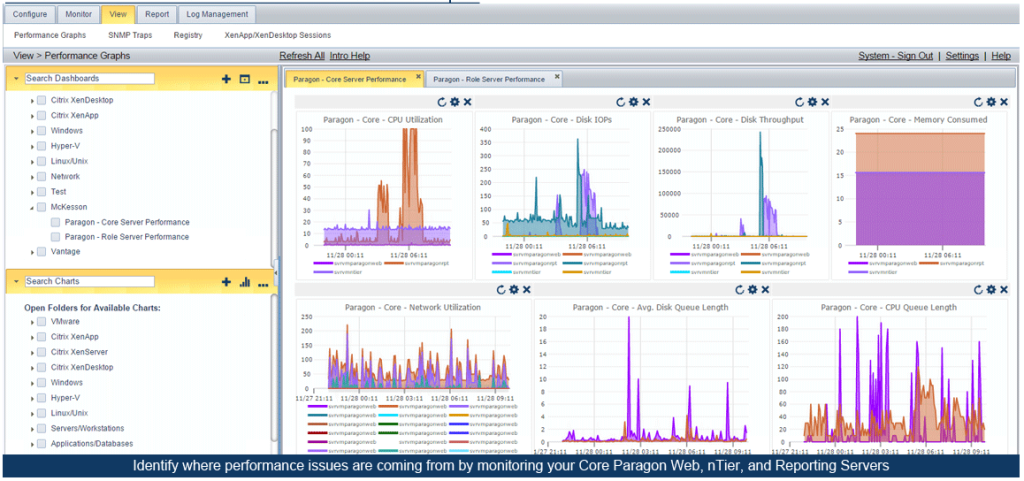Goliath Technologies posted the following article written by Val King, CIO of Val Verde Regional Medical Center and the CEO of Whitehat Virtual Technologies.
As a Healthcare IT CIO, one of my responsibilities is to ensure that our medical staff has uninterrupted access to EHR/EMR applications in order to provide the very best patient care. This can be a real challenge when you find yourself in a difficult environment with Citrix, McKesson Paragon, HPF and now McKesson Patient Folder (MPF), Webstation, nTier, etc.
In addition to relying on Goliath Technologies’ McKesson Performance Monitoring Module, we employ the following 14 actions to proactively manage McKesson Paragon & McKesson Patient Folder.

- Get an assessment of the current state of your McKesson and Citrix. This assessment does not have to be some super fancy, third-party deliverable, if you have the expertise in house. From our experience there are multiple perspectives on each issue and where and what the problems “really” are.
What the actual problems are, what the root cause is, etc. is subject to early-diagnosis syndrome (EDS.) EDS is when well-meaning staff take the first signs of some success at resolving a problem and circulate that information before it can be vetted. The “shoot first, test and confirm later” philosophy is a good way to lose credibility with executive management and key staff that want to celebrate wins just as bad as you do. - If your support infrastructure for McKesson is not broken, this one will not likely mean as much to you. If there is no process for the way support is handled at your organization, this might help a bit to get you going.
Get a single triage point and assemble a team that can tackle the issues from multiple angles simultaneously. We divide issues into McKesson Financial, McKesson Clinical, and IT. We assign specialists to address challenges in their respective category to report problems, offer issue resolution suggestions, and provide updates back to the team. - Get a rock solid test environment for McKesson, Citrix and the supporting infrastructure. Keeping this environment up to date will allow clinical staff a place to train, practice, get up to speed, allow changes to be tested, and allow for new versions and upgrades to be vetted before being sprung on the live environment.
- Don’t touch the jobstream. Don’t do it. If the nightly close fails, call McKesson, they will gladly help you. Use Goliath to setup alerts to notify you in the middle of the night when there is an issue. Problems here are solved by working through each new issue nightly until you eventually arrive at a stable, reliable close process.
- Medical Records should not be printing out of Paragon; this can be a patient safety issue for reasons that will be obvious if that is what you are doing today. McKesson HPF is your friend for printing. Get it setup in Citrix and print away.
- If the Citrix infrastructure is not working properly, McKesson Paragon will not work properly—period, end of discussion. Typically we see printing issues when our clinical staff move from location to location, but their ability to print to the correct printer does not move with them. We see profile problems; we see slow logins and sluggish response. Goliath Technologies has the best product in the market to enable you to get ahead of these issues and also gives you the data to put fix actions in place to prevent them in the future.

- Even in a Citrix environment, a full PC with Paragon on it in each major department can come in handy if your Citrix environment is sketchy and subject to frequent downtime. The best answer is to find someone to get Citrix right and redundant. Plan B would be to use one full blown PC in key areas to make sure work can continue in an outage situation.
- If any of the eleven systems that Citrix relies on to deliver your applications or desktops is not healthy, Citrix will at best be limited in delivering the applications and/or desktops to end users. (Active Directory, mass storage, network hardware, hypervisors, Provisioning/machine creation services, etc.) See Goliath Daily Citrix Health Checks.
- Put a McKesson SuperUser or other knowledgeable team member with your physicians to see them in action and to teach and address issues that pop up as they make their rounds daily. Make sure any issues or education needs are brought to the attention of the group via ticket or other method to make sure that hard fought knowledge does not get lost in the shuffle.
- Create clear lines of communication from the end users reporting issues back to the troubleshooting team. More importantly, acknowledge their requests and follow up with them regularly with status updates, even if nothing has changed, to let them know they have not been forgotten. A little extra care in (internal) customer service efforts can go a long way in keeping your staff cooperative and doing their best to cover any potential gaps in patient care.
- Create a knowledge base to capture what you have learned. In our case, we are deploying McKesson specialists in both the financial and clinical areas as well as Citrix experts. While we create documentation for the environment, the specific steps we have used to resolve issues could very well be lost if the hospital does not have a mechanism to capture exactly what was done and put into a searchable format for future use by the Support Desk. Get the process in place to capture this information or be prepared to pay someone to do this for you again in the future.
- 1Share your wins and the progress that is being made. End users can lose faith or get a bad taste in their mouth from any deployment of Citrix, McKesson or anything that gets off to a shaky start. They can also be extremely difficult to win back. As issues are fixed and problems are remediated, share those wins with the appropriate staff so that they can see that progress is being made, that people care, and that they are not just going to have to tolerate a poor end user experience forever.
- Instrument McKesson and all of its modules for performance. The more reactive you are in learning about and resolving these issues, the more you hurt your reputation with your end users, and the more your support costs will vary in overtime and consulting hours to get them fixed. Put in tools, like Goliath Technologies & Aternity as two examples, that will let you instrument the performance of every key metric of every module in your McKesson software stack. Our objective is to instrument the applications and modules to the point where we will find out about 60% of the issues before the end users do. Most environments today rely on the end user to notify IT when there is an issue.
Statistics from the Aberdeen Group among other industry organizations, state that on average 75% of issues originate with the end user. We also know that statistically, end users will wait on average eight times before reporting an issue, unless it is catastrophic in nature, but will complain to peers the first time there is a problem. - Know when and where to get good help., preferably before a major crisis occurs. Find, acquire, or train great Citrix, McKesson Financial and McKesson Clinical talent. Find the rock stars that can help. An IT generalist or Server Admin without deep Citrix experience is going to have a harder time getting Citrix right when he/she only sees it a handful of times each year. Look for consultants and staff that have that deep expertise to augment your team. Our Citrix guys will see over 100 different Citrix environments this year in one capacity or another; while another company’s Citrix guy might see one or two. Experience matters.
Find out what experience the resources you are looking to employ have before you let them lay hands on your environment. Tools like Goliath Performance Monitor for XenApp and XenDesktop have the intelligence built in to ultimately reduce support tickets using a combination of sophisticated alerts, remediation actions and alert resolution features.
Goliath offers a fully supported 30-day free trial of their Proactive McKesson Performance Monitoring Module.





Leave Comment